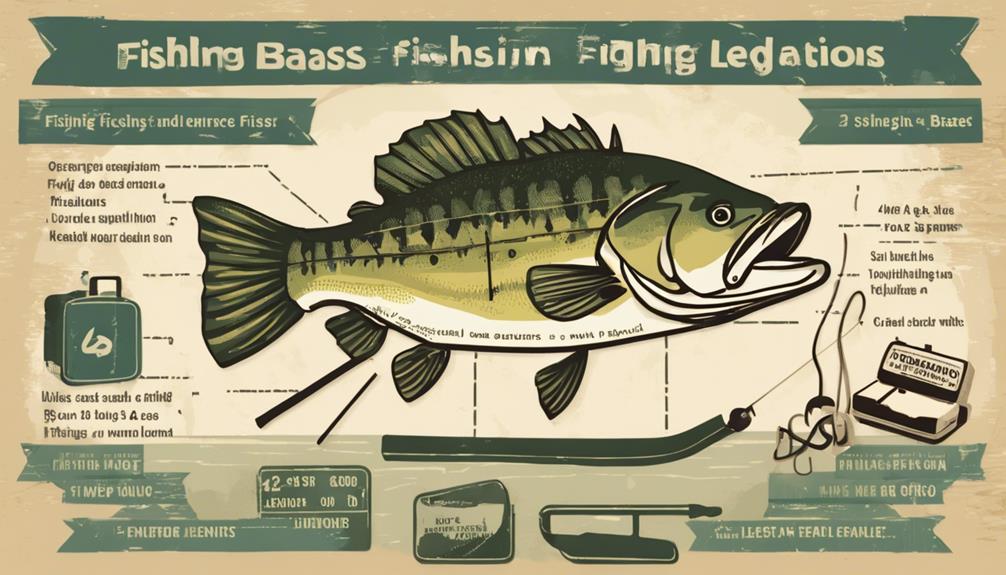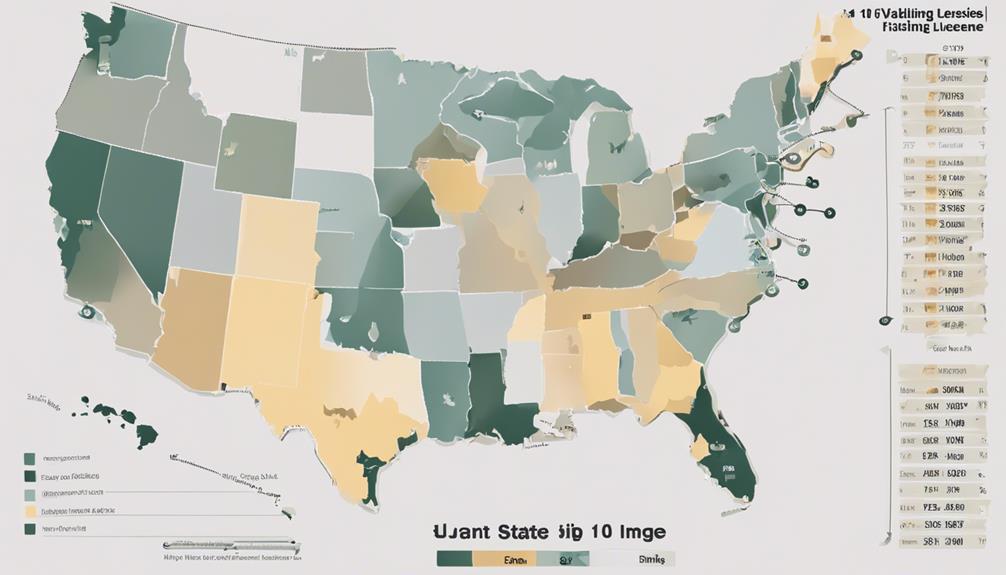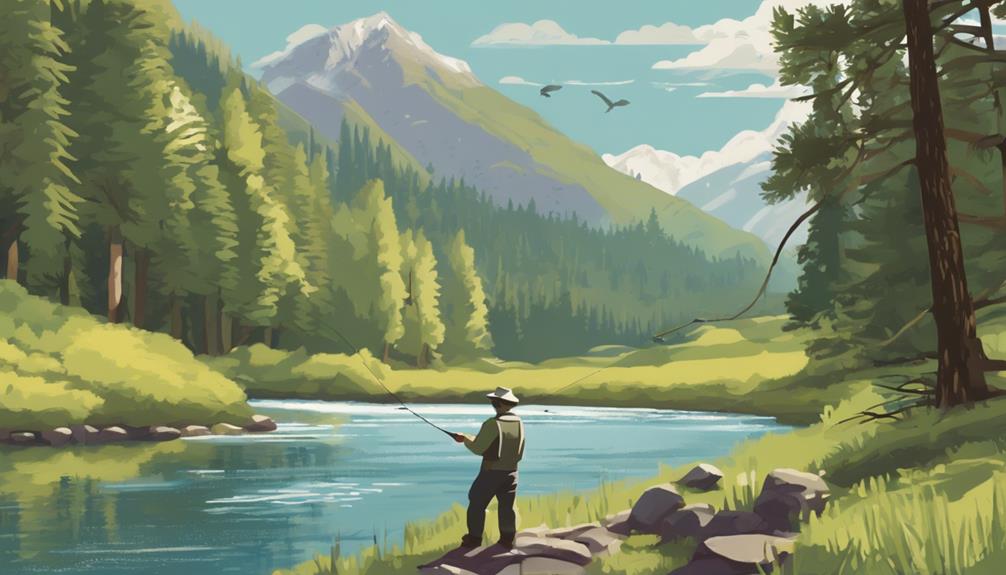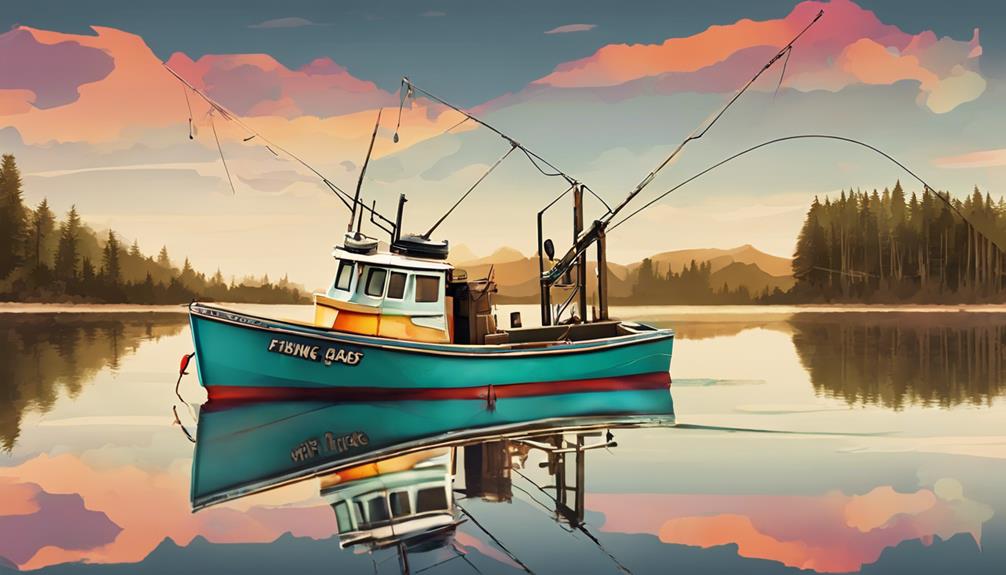Imagine the tranquil waters of a New York freshwater stream, the early morning mist rising as you cast your line. As you navigate these serene fishing spots, knowing the six key regulations can make or break your angling experience.
From license requirements to seasonal closures, each rule plays a crucial role in preserving the state's aquatic ecosystems and ensuring sustainable fishing practices.
Stay tuned to unravel the essential details that every angler should be aware of before embarking on their next fishing adventure in New York.
License Requirements
To legally fish in New York's freshwater bodies, you must possess a valid fishing license. Age restrictions apply when obtaining a fishing permit in New York. Individuals under the age of 16 aren't required to have a fishing license. However, those aged 16 and older need to purchase a fishing license before casting their lines into the state's picturesque waters.
When it comes to fishing permits, New York offers various options to cater to different preferences. The annual fishing license is a popular choice for those who plan to fish frequently throughout the year. If you're a casual angler or just visiting, you can opt for a short-term license, typically valid for a few days. Make sure to check the specific regulations for each type of license to ensure compliance with the state's fishing laws.
Understanding the age restrictions and the different fishing permits available is crucial for enjoying your fishing experience in New York without any legal issues. By obtaining the appropriate fishing license based on your age and fishing needs, you can relax and focus on reeling in your catch while exploring the diverse freshwater fishing opportunities that the state has to offer.
Size and Possession Limits
Make sure you're aware of the size and possession limits when fishing in New York's freshwater bodies to comply with regulations and protect the ecosystem. Size limits are put in place as conservation measures to ensure the sustainability of fish populations. These limits specify the minimum and sometimes maximum size of fish that can be kept. By adhering to these regulations, you contribute to maintaining a healthy fish population for future generations of anglers to enjoy.
Possession limits refer to the maximum number of fish an angler can keep in one day. These limits prevent overfishing and help distribute the catch more equitably among all anglers. It's essential to know the specific possession limits for the water body you're fishing in, as these can vary depending on the species of fish and the location.
Violating size and possession limits not only puts you at risk of fines and penalties but also harms the delicate balance of the aquatic ecosystem. When you abide by these regulations, you play a crucial role in the conservation of fish populations and the overall health of freshwater environments. Always check the most up-to-date size and possession limits before heading out to fish, and remember that responsible fishing practices benefit everyone.
Catch and Release Policies
Adhere to catch and release policies to promote sustainable fishing practices and conservation efforts. When you release fish back into the water, you contribute to the preservation of fish populations and minimize your environmental impact.
Here are some important points to consider:
- Preserve Fish Population: By releasing some of the fish you catch, you allow them to continue breeding and contributing to the overall population. This helps maintain a healthy ecosystem and ensures future generations of fish.
- Environmental Impact: Catch and release fishing reduces the pressure on fish populations, especially in areas where overfishing is a concern. It helps maintain the balance of species in the ecosystem and minimizes the risk of depleting certain fish populations.
- Promote Conservation: Engaging in catch and release practices shows your commitment to conservation. It demonstrates an understanding of the importance of protecting natural resources for future enjoyment.
- Educate Others: By following catch and release guidelines, you set an example for other anglers. Sharing your knowledge and promoting sustainable fishing practices can have a ripple effect, encouraging more people to fish responsibly.
Special Fishing Zones
Explore the designated Special Fishing Zones for unique angling experiences and regulations tailored to specific conservation needs. These zones are established to protect sensitive habitats, endangered species, or to promote sustainable fishing practices. By focusing on conservation efforts, these areas aim to ensure the long-term health of fish populations and their ecosystems.
When fishing in Special Fishing Zones, it's crucial to adhere to the specific regulations set forth for each area. These regulations may include restrictions on certain fishing techniques to minimize environmental impact and protect vulnerable species. Anglers are encouraged to familiarize themselves with the rules governing these zones to contribute to conservation efforts while enjoying their fishing experience.
Special Fishing Zones also provide anglers with the opportunity to learn and practice different fishing techniques. These areas may have unique challenges that require specific approaches, enhancing the angling skills of those who fish there. Whether it's fly fishing in a designated trout conservation area or using specialized gear for catch-and-release practices, anglers can expand their fishing techniques while supporting conservation goals.
Bait and Tackle Restrictions
Fishing in Special Fishing Zones requires compliance with specific bait and tackle restrictions to protect the ecosystem and fish populations. To ensure sustainable fishing practices and the preservation of aquatic habitats, New York imposes various regulations on bait and tackle usage. Here are the key restrictions you need to be aware of:
- Artificial lures: In Special Fishing Zones, the use of artificial lures is often encouraged as they've minimal impact on fish populations and the environment. Make sure to check the specific regulations for each zone regarding the types of artificial lures allowed.
- Live bait restrictions: To prevent the introduction of invasive species and diseases, there are restrictions on the use of live bait in certain areas. Always verify which live baits are permitted and where they can be used to avoid penalties.
- Fishing gear limitations: Some Special Fishing Zones have restrictions on the types of fishing gear that can be used to maintain the balance of fish populations. It's essential to adhere to these limitations to promote conservation efforts and sustainable fishing practices.
- Conservation practices: Practicing catch and release, following size limits, and using barbless hooks are common conservation practices required in Special Fishing Zones. By following these guidelines, you contribute to the long-term health of the fishery and ecosystem.
Seasonal Fishing Closures
During specific times of the year, certain water bodies in New York are closed to fishing activities to protect spawning fish populations and ensure their sustainability. These seasonal fishing closures play a vital role in wildlife protection and conservation efforts by safeguarding vulnerable fish during their reproductive cycles. By restricting fishing access during critical spawning periods, authorities help maintain healthy fish populations and promote sustainable fishing practices.
The implementation of seasonal fishing closures also has a significant impact on environmental conservation and ecosystem management. Allowing fish to spawn undisturbed helps maintain the natural balance of aquatic ecosystems, ensuring the continued health of not only the fish populations but also the overall biodiversity of the water bodies. These closures enable fish to reproduce successfully, leading to the replenishment of stocks and the preservation of genetic diversity within fish populations.
It is crucial for anglers to adhere to these seasonal closures to support the long-term health of New York's freshwater habitats. By respecting these regulations, fishers contribute to the preservation of aquatic ecosystems and the prosperity of fish populations for future generations. Remember, by following these guidelines, you're playing an active role in promoting sustainable fishing practices and protecting the natural environment.
Boating Regulations
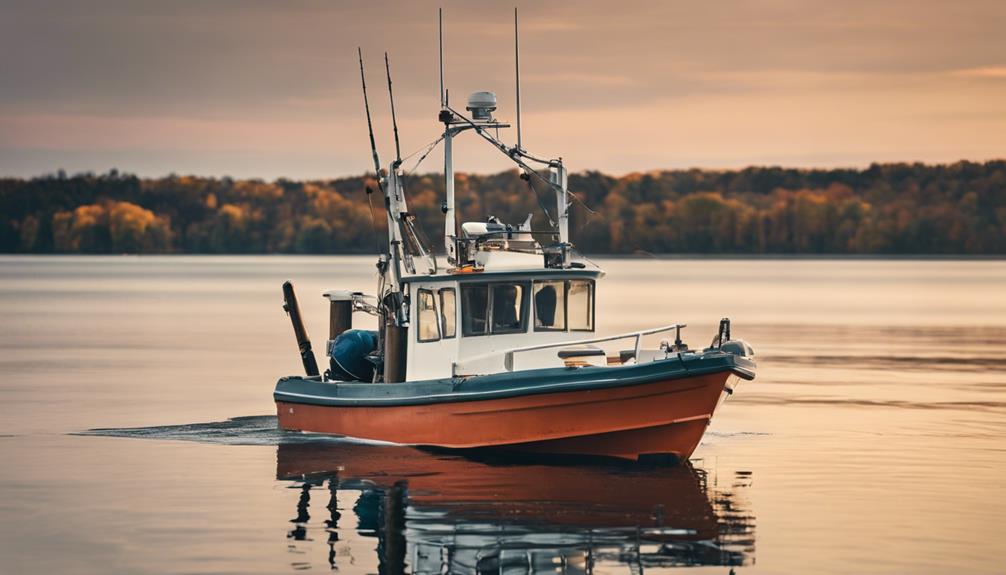
To ensure safe and responsible navigation on New York's freshwater bodies, familiarity with boating regulations is essential. Whether you're cruising on the Hudson River or fishing in the Finger Lakes, abiding by the rules ensures a pleasant experience for all. Here are some crucial points to keep in mind:
- Safety Guidelines: Prioritize safety by wearing a U.S. Coast Guard-approved life jacket at all times while boating in New York waters. Remember to follow speed limits, especially in congested areas, and avoid reckless maneuvers that could endanger yourself or others.
- Equipment Requirements: Make sure your boat is equipped with the necessary safety gear, including a sound-producing device like a whistle or horn, visual distress signals, and a fire extinguisher if applicable. Having these items on board not only keeps you compliant with regulations but also prepares you for unexpected situations.
- Boating Under the Influence: It's illegal to operate a boat while under the influence of alcohol or drugs in New York. Stay safe and designate a sober driver if alcohol will be part of your boating experience.
- Navigation Lights: When boating between sunset and sunrise, ensure your vessel has the required navigation lights illuminated. Proper lighting helps other boaters see you and prevents collisions in low visibility conditions.
Enforcement and Penalties
Ensure compliance with New York's freshwater boating regulations to avoid enforcement actions and penalties. Violating these regulations can lead to severe consequences, including fines, suspension of fishing privileges, and even criminal charges. The penalty enforcement for breaking these rules is taken seriously to protect the environment and ensure the safety of all anglers.
If you're found in violation of New York's freshwater fishing regulations, you may face various penalty enforcement measures. Depending on the severity of the offense, you could be subject to fines ranging from $50 to $250, with potential additional court costs. In more serious cases, such as repeated violations or harming protected species, the consequences may escalate to include the suspension of your fishing license and privileges. These penalty enforcement actions aim to deter illegal activities and safeguard the state's natural resources.
To avoid violation consequences, make sure to familiarize yourself with all applicable regulations before heading out to fish in New York's freshwater bodies. Respect size limits, catch quotas, and seasonal restrictions to stay within the legal boundaries. Additionally, follow all boating regulations, such as having the required safety equipment on board and adhering to no-wake zones. By abiding by these rules, you can enjoy your fishing experience without facing enforcement actions or penalties.
Frequently Asked Questions
Can Anglers Use Drones to Assist in Fishing in New York's Freshwater Bodies?
Yes, anglers can use drones to assist in fishing in New York's freshwater bodies. However, there are ethical concerns regarding drone fishing, such as potential harm to wildlife.
Additionally, drone regulations exist to address privacy issues and ensure safe drone operation. It's important to be mindful of these factors while using drones for fishing to promote responsible and sustainable fishing practices.
Are There Any Restrictions on the Use of Underwater Cameras While Fishing in New York?
When fishing in New York, using underwater cameras is generally allowed, but there are restrictions. Make sure to check local regulations to stay compliant.
These rules aim to protect fish populations and their habitats. Remember to always follow guidelines to ensure a sustainable fishing environment.
Are There Any Specific Regulations Regarding the Use of Fish Finders or Sonar Devices While Fishing?
When you're out fishing in New York, you'll find that using fish finders and sonar devices can be a game-changer for your fishing techniques. These pieces of technology help you locate fish more efficiently, improving your chances of a successful catch.
While New York doesn't have specific regulations on fish finders or sonar devices, using them responsibly can enhance your fishing experience and make it more enjoyable. So, feel free to utilize these tools to up your fishing game!
Are There Any Guidelines for the Use of Artificial Fish Attractants or Scents While Freshwater Fishing in New York?
When you're fishing in New York's freshwater, using scent attractants can be a game-changer. They can enhance the effectiveness of your bait by attracting fish with their natural scents.
Artificial lures are also a popular choice due to their benefits like durability and versatility. Incorporating these elements into your fishing routine can increase your chances of a successful catch and make your fishing experience more rewarding.
Are There Any Regulations on the Use of Live Bait Versus Artificial Lures in Certain Freshwater Fishing Areas in New York?
When fishing in certain New York freshwater areas, you need to know the live bait regulations versus artificial lures. Some spots might have specific rules about what you can use.
It's important to stay up to date with these regulations to ensure you're fishing within the guidelines. Consider exploring different fishing techniques and equipment innovations to adapt to any restrictions while still enjoying your time on the water.
Conclusion
Overall, make sure to familiarize yourself with the six key freshwater fishing regulations in New York to ensure a successful and enjoyable fishing experience.
Remember to always have your fishing license, abide by size and possession limits, practice catch and release, respect special fishing zones, comply with bait and tackle restrictions, and be aware of seasonal closures.
By following these regulations, you can help preserve New York's freshwater fisheries for future generations to enjoy.
Happy fishing!
